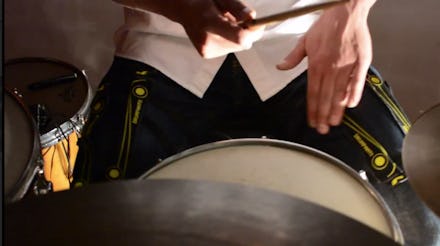These Genius New Pants Could Give People Who Can't Speak a Way to Communicate

When Tyler Freeman set out to create the first industrially produced wearable, portable, wireless drum set, he thought the technology would be a great way to make drumming more portable and cost effective. Rehabilitation Specialist Michael Zinn saw in DrumPants potential for a different purpose. He realized the same wearable could help people with nonverbal disabilities communicate with those around them. Intrigued by the possibility, Zinn asked the DrumPants team if he could use a few prototypes to test his theory out.
From the original product, Zinn worked with the DrumPants team to develop DrumPants Trigger Activated Personal aSsistant or "TAPS." The system helps those who physically can't speak — people with amyotrophic lateral sclerosis, brain injuries or cerebral palsy — communicate. The wearable connects to wheelchairs, canes or clothing, and the user can hit one of the many sensors to trigger pre-recorded phrases that sound from a Bluetooth-connected smartphone or tablet.
"We gave him a couple of DrumPants kits, and we worked with him to create this app," DrumPants CEO and Co-Founder Lei Yu told Mic . "You can type in a custom phrase. It can be as simple as 'yes' or 'no,' or as complicated as 'I want donuts,' and then all they need to do is tap on [a sensor], and it can trigger that phrase to be spoken."
This technology helps with one of the crucial barriers of communication for people with nonverbal disabilities. Without the help of technology, people who can't speak are only able to communicate through people who understand sign language or the nonverbal symbols they use. Even those symbols limit communication to people within eyesight — they don't transmit sound, so it's hard to keep the conversation going if the recipient is in another room.
Zinn and the DrumPants team saw the device helping patients with this issue in beta testing.
"There's a mom in Canada who has ALS. She can communicate with you as long as she can look at you, but if her kids are in the other room, and she needs them for some reason, she can tap on her leg and her phone will call out to her children," Freeman told Mic . "It's just really amazing seeing what we made being used for a totally different purpose."
A number of assistive technologies exist to help people with nonverbal disabilities speak, ranging from special keyboards to iPhone apps. These tools all help eliminate the same problem DrumPants TAPS addresses: giving nonverbal patients back the ability to speak on their own. While TAPS is a product that can easily mesh with a wheelchair or attach to clothing, the device only emits pre-recorded phrases, so full un-interrupted communication with original phrases will still be a challenge for people using the product.
But while TAPS is not the only assistive technology available for people with nonverbal disabilities, it does offer nonverbal patients with limited dexterity a new, realistic option for communication. The flexibility of DrumPants TAPS — being able to attach it to anything and its simple tapping operation — provides a more versatile range of options than typing on a full keyboard.
DrumPants TAPS is still in the beta testing phase; Zinn and his team have entered the AT&T NYU Connect Ability Challenge in an effort to raise funding for further development and programming. The team hopes to use that funding for a number of developments, including adding a person's authentic voice instead of a pre-recorded one, making most commonly used phrases available through certain sensors and exploring how to use DrumPants as a musical therapy device for people with autism.
DrumPants TAPS is just one of the many nonmusical uses born from the original DrumPants, which finished an Indiegogo campaign in July, raising over $42,000 to produce DrumPants 2.0. With this next release of DrumPants, Yu and Freeman are making the product open source.
"What it came down to was a lot of our customers would email us and say, 'Hey, this is really cool, but can it do x or can it do y,' and so, being makers, we were like yeah of course it can, but our team was too small to support all of these features that our customers wanted," Yu said.
Making DrumPants open source and exploring new uses for the product reflects a shift in the company itself. While Yu and Freeman originally founded DrumPants together, they changed the company name to Tappur in June 2014 with a new mission in mind. Freeman told Mic Tappur will be focused on creating wearable technologies that utilize the tapping gesture to make people's lives easier and more efficient.
"The future is coming, and there's going to be more people trying to figure out the best way to make people's lives simpler, easier and more streamlined," Freeman said. "That's our overall mission. How do we do this using wearables and wireless technology?"
This series is part of a collaboration between Qualcomm® Snapdragon™ and Mic to explore how technology impacts our generation's relationship with music. With a Snapdragon processor powering your phone, you'll experience music with superior surround-sound, and epically-fast 4G LTE. This story was written by Mic's branded content team with no involvement from Mic's editorial staff. For more stories in this series, click here >>